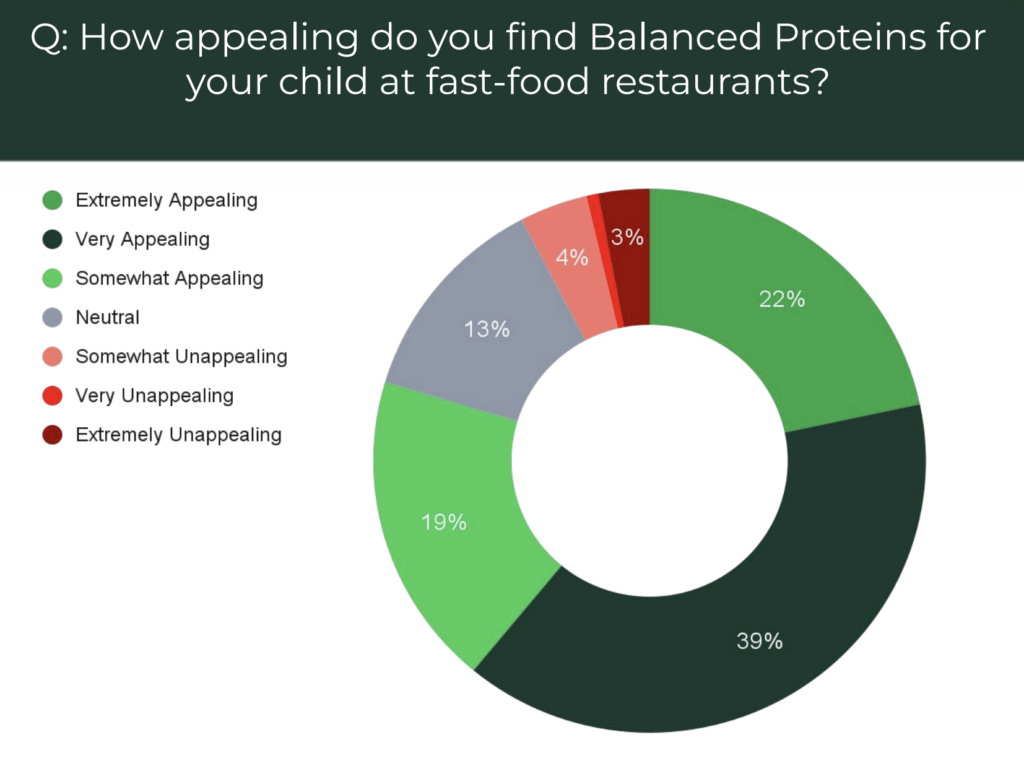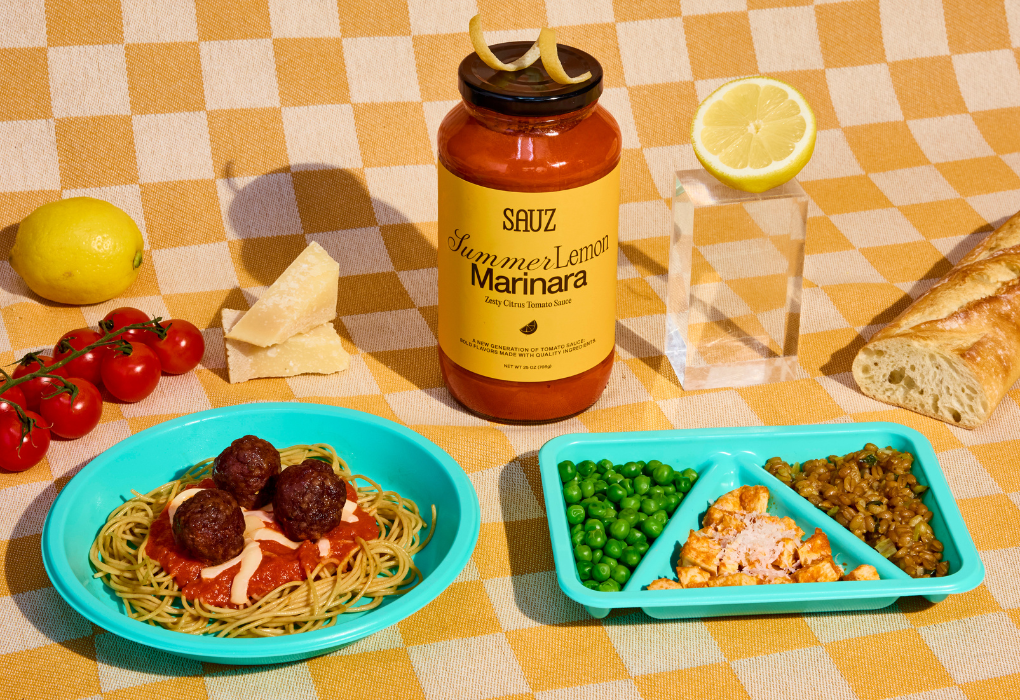
Kid-focused meals in fast-food restaurants are unhealthy and increasingly expensive, but parents believe blending meat with plants could be a real win-win.
As the state of kids’ meals in schools dominates headlines in the US and internationally, a new report presents a healthier solution in another key setting: fast-food chains.
Nine in 10 American parents take their children to a fast-food restaurant at least once a month, and 85% say specific options for their kids – like a Happy Meal at McDonald’s – are essential to making an outlet kid-friendly.
The problem is, 72% of kids’ meals at the top 50 chains fail to meet expert nutrition standards, prompting local governments to step in with regulations mandating a portion of fruits and vegetables or a lean protein as the entrée.
Today, 58% of parents want healthier items on kids’ menus, and nearly half want more variety. Plus, a third are looking for more affordable options, given that major chains like Chick-fil-A, Popeyes, and McDonald’s have raised kids’ meal prices by around 60% over the last decade.
And though 85% of Americans say nutrition is the top priority for their children’s diets, the same number struggle to get their kids to eat healthier food. Moreover, 82% of parents say taste is a major purchasing driver of foods for their children.
The research, conducted by non-profit Food Systems Innovation (FSI), points to a “seamless solution” to these issues: balanced proteins. These products combine meat with at least 30% plant-based ingredients to offer health, flavour, and environmental advantages – and parents seem happy to embrace them.
Why parents are lapping up blended meat

Proponents of blended proteins argue that by replacing some of the meat with plant proteins or vegetables, you can reduce saturated fat and cholesterol levels, and increase fibre. Additionally, it reduces the climate impact of these products, as animal proteins account for nearly 60% of the food system’s emissions.
Crucially, there is little to no trade-off in the taste experience. Sensory testing by Nectar, an FSI subsidiary, suggests that over 50% of omnivores found 11 of 22 blended protein products as good or better-tasting than conventional meat. In fact, three were ranked as better-tasting than 100% meat by a majority of participants, and one was preferred equally to beef.
FSI surveyed 300 American parents to gauge their thoughts on blended meat for kids, and 80% said they found the concept appealing in a fast-food setting. Three in four agreed that balanced proteins can get their young ones to eat healthier, and would choose restaurants that serve these options over those that don’t.
“Nutrition is a top concern for parents, but it constantly runs up against real-world trade-offs like what their child will actually eat, how much time they have to prepare it, and what they can afford. Balanced Proteins help bridge that gap,” Tim Dale, category innovation director at FSI, tells Green Queen.
“They add meaningful nutrients, like fibre, without changing the taste, texture, or familiarity of the foods kids already love. For parents, that means fewer mealtime battles and less guilt, and for kids, it means the same burgers and nuggets they already enjoy. It’s an easy win on both sides of the table.”
Americans are happy to pay more for balanced proteins

Interestingly, 58% of parents say they’d shell out more for a blended meat option in restaurant settings, with 12% happy to pay significantly more. In fact, less than 5% suggest that they’ll only consider balanced proteins if they’re cheaper.
“There’s always a gap between what consumers say and what they actually do, but we’ve already seen proof points in retail showing that parents are willing to pay slightly more for products that deliver clear value,” explains Dale.
He believes the results show parents intuitively understand why blended meats exist. “The value proposition is clear and compelling: better nutrition, same great taste, familiar foods their kids already love,” he says.
“There’s a common analogy that gets thrown around in startup communities – you want to sell pain relievers, not supplements. Balanced proteins are a pain reliever. They solve a real problem for parents: getting kids to eat healthier foods without a fight. When a product makes family meals healthier and still enjoyable, a small price premium is justified in many parents’ minds.”
In terms of product format, the research shows that multiple products exhibit interest levels above 45%. The most popular items are chicken nuggets, which 77% of parents would likely choose for their kids, followed closely by burgers.
“They’re familiar, easy to trust, and already part of the restaurant routine,” says Dale. “That said, parents are increasingly attentive to ingredient quality.” In FSI’s qualitative interviews, some parents voiced concerns about overly processed foods or unfamiliar ingredients.
“If I were a restaurant looking to introduce a balanced protein kids’ meal, I’d focus on three things. Message reassurance: highlight that it’s still the meat your kid knows and loves. Deliver a clear nutritional improvement, such as more fibre or leaner protein. Keep the ingredient list simple and recognisable.”
Perdue, Disneyland and others show the way forward

FSI highlighted three case studies that prove the potential of blended meat for children. These include Perdue Farms’s Chicken Plus range (developed with The Better Meat Co), Disneyland’s launch of 50/50 Foods’s Both Burger, and Fable Food’s mushroom-beef meatballs for Little Spoon’s kid-centric pasta meal.
“Perdue nailed the messaging,” notes Dale. “By communicating vegetable content volumetrically (‘1/4 cup of vegetables per serving’) instead of by percentage, they met USDA labelling requirements and reinforced a key consumer perception that it’s an additive story, not a subtraction story. It’s the same chicken, now with more nutritious ingredients included.
“Disney and 50/50 Foods showed how to bring this concept to life on menus. Their naming and presentation are fun, familiar, and craveable. The Meteorite Medley Burger doesn’t communicate sacrifice or compromise – it’s just an enticing name that will pique your interest.
“Little Spoon and Fable Food understood the parent mindset perfectly. Their Fable shiitake-infused meatballs make it effortless for busy parents to add more fibre and nutrition to mealtime, while simplifying routines and minimising resistance from kids.”
Clearly, there’s a lot of room for success, so what’s holding restaurants back from introducing blended meat? Dale says foodservice operators have a few key questions. Who’s this for? Who’s going to want it? And how will this work operationally?
“This report is meant to address that first question head-on, showing clear evidence that there’s a real market opportunity for balanced proteins in kids’ meals. Parents are asking for healthier, familiar options, and balanced proteins meet that need directly,” he argues.
“On the operational side, hesitation is understandable. In a period of economic uncertainty, many chains are cautious about adopting new product categories. My recommendation is to start small through limited-time offers or structured store tests in order to evaluate customer response and operational fit.”
While FSA hasn’t conducted formal sensory tests with children, Dale says the continued success of products like Perdue Chicken Plus and KidFresh’s chicken meatballs and nuggets reinforces the category’s taste potential: “When taste is familiar and the product looks like the foods kids already love, acceptance tends to follow quickly.”
How restaurants can integrate blended proteins

According to Dale, the biggest mistake restaurant chains can make is leading with novelty instead of what’s tried and tested. “Parents don’t want to gamble on a product their kids might reject, and kids themselves often drive the meal choice, with parents simply approving the final call. That dynamic makes reassurance and fun equally important,” he says.
He urges operators to retain classic formats like burgers and nuggets and name them in an exciting, not confusing way. “Instead of a ‘hybrid meat + plant burger’, call it something like the Mighty Mix Burger or Power Bites,” he suggests.
“Reassure parents. Use the menu and visuals to make clear that this is the same meat their kids already love – just with added nutrition. Lean on phrases like ‘100% real beef with added veggies’ or ‘made better for growing kids’.”
It’s also important to feature crave-worthy photos, taste-test videos, or real-parent testimonials to reinforce a taste-first experience. “Lower the stakes for trial. Offer samples, coupons, or satisfaction guarantees to make parents feel safe testing something new,” adds Dale.
“Above all, position the product as an upgrade to a family favourite – not a replacement or moral choice. When you make it easy, tasty, and joyful, both parents and kids will say yes.”
The research comes at a time when children’s nutrition, particularly in schools, is a hot topic in food policy. In the US, the Trump administration’s funding cuts to food assistance programmes will make it harder for children to access nutritious food, in contrast with the MAHA movement’s promise of healthier food for kids.
On a global level, increased government spending has led to a major hike in the number of children receiving free school meals (up by 80 million since 2020), but at the same time, Unesco is calling for more nutritious food options and the inclusion of food education in school curricula.
Some countries are already emphasising the protein transition. Schools in Spain are now legally required to serve fruits, vegetables and vegan meals as part of their lunches, and Taiwanese legislators are asking the government to add plant-based meat to school meals.
And a study led by the Scottish government has concluded that replacing meat and dairy with plant-based alternatives can help the nation achieve its health and climate goals.
The post With Kids’ Meals in Focus, 75% of US Parents Find Blended Meat A Healthy Fast-Food Option appeared first on Green Queen.
This post was originally published on Green Queen.